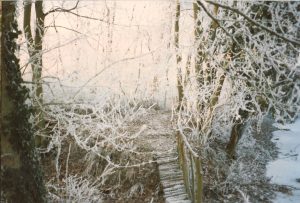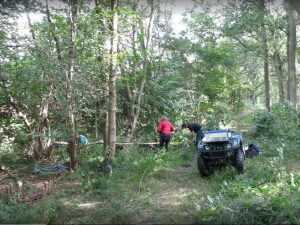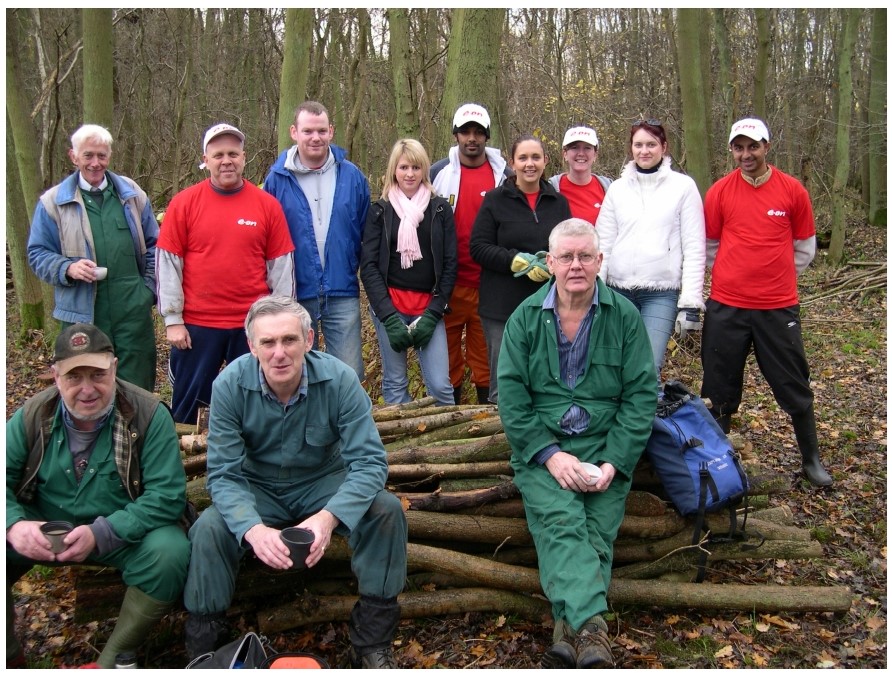Page last updated: 27/01/19
Lyveden New Bield
The Re-Discovery Story
Introducing Mark Bradshaw & Bob Oakley
and other Outdoor Team Members
In 1992, Mark Bradshaw (aged 22) was a university student in his final year studying Rural Land Management. His eventual aim was to be employed as a rural land agent. “I had never heard of Lyveden, but had imagined the possibility of being employed by the National Trust. In order to further that possibility, I contacted the National Trust to enquire about the possibility of doing some voluntary work during my summer holidays.” It was from that enquiry that he learnt of the property at Lyveden and in the summer of 1992, Mark began voluntary work at Lyveden New Bield.
On his first day, Mark remembers that it was a beautiful summer day as he walked up the track having parked at the bottom on Harley Way. “All the way up, I could see nothing on the right hand side due to scrub and bramble growing right up to the track edge. There were ploughed fields on both the north (Parterre Meadow) and south (Hay Meadow) sides of the Lodge. Heading west from cottage was like walking into woodland. A fence surrounded the New Bield ‘platform’ and cottage.
“I remember meeting the Custodian, a man called Ted Faulkner (a retired police officer). He and his wife Enid were a lovely couple, and lived in the cottage. Ted was employed on a part time basis, and his main role was to ‘meet and greet’ the occasional visitor, who would have walked up from Harley Way. They’d ring a bell on the gate at the front of the cottage, and be given a ticket and guide book if they wanted one, all for about a pound.” From the cottage, visitors would walk round toward the Lodge, through a little hand gate, and be left to do their own tour. There were no other facilities.
“The guide book at that time really only covered the Lodge, although there was a page at the back that showed some information from the 1901 historic survey. This showed the manor house, orchard, and the layout of the Elizabethan garden.”
In addition to his ‘meet and greet’ role, Ted also maintained the visitor areas leading to, and within the lodge. The cottage garden itself was a private area that Ted kept in order. Some clearing work was undertaken in the wooded areas of the Elizabethan garden, but primarily as a means of obtaining wood for heating the cottage.
There was no visitor access to the features that formed the Elizabethan Garden. A fence and hedge blocked access to East Wood (see map2), and the only access to the Moated Orchard was through a gate off the track which was marked ‘Private – Keep Out’ due to the Duke’s shooting rights. Even if access had been provided, it would have been too difficult for visitors to reach these areas because of the dense undergrowth (particularly in the summer months).
Ted used to have the occasional volunteer (often ex colleagues, or friends from Kettering), to help keep the Lodge and its immediate surrounds tidy, and carry out any minor maintenance work. One of his priorities was to maintain sufficient split logs near the cottage to keep the heating going through the cold periods.
Two thirds of the garage (which is still there today (2018)) was filled with the water filter system. Water from the moats was pumped into the garage, through different sized granules of sand and a UV system to make it suitable for drinking (by the standards in those days). From there it was pumped to the cottage.
Typically working two or three days a month during the 1992 college holiday, Mark estimates that he probably did a total of 10 days.  “There were only two of us, and most of the time, we were working near a bridge, taking out some willows. To get there we’d go through what was in effect woodland, and cross a little wooded bridge made of split timbers. It wasn’t really a bridge, because it was crossing what was really a muddy marsh.”
“There were only two of us, and most of the time, we were working near a bridge, taking out some willows. To get there we’d go through what was in effect woodland, and cross a little wooded bridge made of split timbers. It wasn’t really a bridge, because it was crossing what was really a muddy marsh.”
“We’d return to the cottage for a tea break, or lunch. I always remembered what a delightful cottage it was in the Northamptonshire countryside.”
Bob Oakley had been brought up in and around forestry in Northumberland, and then been employed in various rural roles. As a result, he had a wealth of knowledge and experience on most things forestry and horticulture. For his final career move, Bob worked for 20 years for the Peterborough Development Corporation’s landscape department. He had heard about Lyveden New Bield, and had often thought about visiting the property but never got round to it.
One day in the summer of 1993, he and a colleague were working in Corby. He had noticed the Lyveden road sign on their way to Corby, and thought that if they were not too late on their return, would make a point of visiting. They did visit, and Bob remembers that the building (the Lodge) was both interesting and unusual. On their way back down the hill, he thought he noticed through the scrub and bramble, something that looked like water which he assumed was a pond. He decided to push his way through the vegetation to take a look. What he came across was quite a surprise – not a pond, but something rather more substantial. Under all the fallen trees and general debris was not just a pond and some spoil heaps, but a long moat and a mound that were obviously not a natural feature, but man made. Bob also thought he could see some raised ground at the far end of the moat. Here, he remembers thinking, really was something quite impressive.
Mark finished university, and went on to Cambridge until 1994 to do a Masters in Land Economy. He didn’t visit Lyveden, or really think much more about the property. However, his parents used to visit Ted occasionally because they and Ted had a joint interest in wood turning.
Mark got a job with Carter Jonas in Peterborough as a trainee while doing professional exams. He remained with Carter Jonas for about 12 months managing Glebe land (owned by Peterborough Diocesan). “I soon realised I did not really enjoy the work, and missed hands-on outdoor work. Instead, my job involved working on tenancy agreements, forming licences etc. Most of the time I would spend in the office. Occasionally, I would get into a car, drive to a field, and then back into the car to go back to the office! The commercial side of land management was not what I wanted for a career.”
Mark remembers talking to his mother on one occasion in the Spring of 1995, and she said that she had read in the local paper that Ted Falkner had retired, and that the National Trust were advertising for a new custodian at Lyveden. The position was part time, and offered a salary of £6900 a year with accommodation provided. The salary was much less than he was then being paid, but his partner had a good job, and they thought they could manage.
They both went up to Lyveden to have a look – as usual, parking down on Harley Way and walking up to the cottage. “Obviously, Ted had been gone for some time because the cottage garden looked as if nothing had been done for 10 months. The grass around the Lodge had not been cut for some time; the lodge appeared to be sitting in the middle of a hay meadow. The cottage itself was being ripped apart because of damp problems. All the walls were bare inside, and there was a pungent damp smell about the place. However, it was a beautiful summers day, and to us it was idyllic.”
Mark knew what was there on that site. He knew that under all that scrub was a garden of huge significance. It was an opportunity and challenge to recover something that had been very much forgotten about and neglected by the Trust. They decided that Mark should apply for the job.
A few weeks later, Mark was interviewed in the cottage front room – still no plaster on the walls. “I remember walking up the hill having parked at the bottom. There was a crab apple tree on the right, full of blossom, and the tree is still there today.” Following a second interview at Clumber Park, (“It was the 5th of May 1995 – funny how some dates stick in the memory!”) Mark was appointed and started working at Lyveden in the late summer of 1995.
Coincidently, within two months of Mark starting at Lyveden, Bob Oakley, who had just retired, decided to visit Lyveden again with his wife. He met Mark and his friend Nick, who Bob later discovered was lodging at the cottage, and who Mark used to press-gang into helping with some clearing work. Mark explained what his plans were for clearing the site to uncover what was apparently an Elizabethan garden. Bob thought how inspired that was, and how exciting it would be to be doing that work. Mark said he was looking for volunteers, Bob offered to do Wednesdays, and that’s how it started.
Mark comments that “In the early years, particularly during the summer periods, Bob and I used to start at 8am, and continue until 6pm, with only a few short breaks for refreshment. Bob must have been worn out after a few years of this toil, it’s no wonder that after 5 years, he went off on a 10 month world tour! A well earned rest.
“A lot changed here at Lyveden over the past 20 odd years. We had some advantages here at Lyveden out in the sticks – things normally change quite slowly with the National Trust, but we used to just get on and do it! The orchard is a good example. Bob Oakley and I just went to Brogdale, identified the species we wanted; Claire Bense researched and designed the layout, and we just got on with the planting.”
“I absolutely loved those first ten years at Lyveden. Every day was a joy; it was not work. We would clear a particular area, and then look back and say to ourselves “Wow, just look at that. You can now see how this area connects to that feature.” In addition, “we’d appreciated the impact we were making when the occasional visitor would comment favourably on the improvements.”
Bob points out that Mark “had to put up with a lot of stick in the earlier years over his vision” of clearing so much woodland, and keeping the features so closely trimmed (manicured?). Bob says that when he worked for the Development Corporation, their priority was to keep the grass areas trimmed at all times. He said if the grass areas were clean/tidy/smart (on the parkways, the verges, the play areas, the parks etc), it made the whole area look good – even if the hedges, woodland and shrub areas needed attention.
He added that “Mark was very meticulous in planning each aspect of the clearing work – how long it would take, what help was needed, where to get that help from, and how to pay for it.”
The Outdoor Teams (from 2001)
Nearly all the clearing work was undertaken by Mark and Bob between mid 1995 and late 2001. By that time, more help was needed simply to maintain the garden to the standards then established.
From 2001 to c2004, Mark could rely on the support of 2 volunteer days a week. Gradually, Mark’s other workload meant that he could not spend as much time as he would like on outdoor activities, and so more volunteers were needed, with each one being encouraged to commit to a regular 1 day a week routine. As a result, the outdoor team strength gradually increase to number around 6 by 2008. By this point, the team tended to split into 2 groups, still working with Mark, but on a different day in the week. This meant that during the grass growing season, the mowers and strimmers could be put to use 2 days a week.
The workload through spring, summer and autumn tended to concentrate on mowing and strimming, with occasional forays into the moats to pull out reeds and weed. Through late autumn, winter and early spring, the workload changed to include annual maintenance such as cutting and clearing woodland areas; hedge planting; hedge laying; hedge maintenance; and fencing.
Comments from some of these volunteers recall that normally, in the early days, when they arrived at Lyveden (around 8:30), Mark had obviously planned exactly what was to be done that day. The equipment would be fuelled and ready to go. Mark himself would probably have started doing the work, but would soon return to the cottage to welcome his ‘team’ and (over coffee) detail the day’s plan. The day would normally be split into three 2 hour sessions, separated by mid morning and lunch breaks. It was only on quite rare occasions that Mark would not be there working with the team.
A few years later (the late 2000s), Mark was seconded to other National Trust sites (mainly Cannons Ashby and Clumber Park), initially for 1 or 2 days a week, and then full time for longer periods. In the absence of a leader on site, planning tasks and coordination between volunteer warden teams began to deteriorate. This eventually reached the point where the volunteers were having to tour the site each day to determine what work needed doing. A rather unsatisfactory situation, which lasted for a number of months before a new leader was appointed – but that is outside the scope of this report.
Other Outdoor Volunteers
 In addition to the regular outdoor teams, Mark also had support from other volunteer groups. These came to Lyveden from time to time, usually to undertake some specific task. Cambridge National Trust Volunteers (CNTV) frequently came to Lyveden over the 2009 – 2011 period. Some of the tasks were to erect the wooden tree guards on Bradshaw Green; to pull reeds out of the moats; or (as shown in this image taken by Paul Hollinghurst) to collect stakes from Lady Wood for hedge laying.
In addition to the regular outdoor teams, Mark also had support from other volunteer groups. These came to Lyveden from time to time, usually to undertake some specific task. Cambridge National Trust Volunteers (CNTV) frequently came to Lyveden over the 2009 – 2011 period. Some of the tasks were to erect the wooden tree guards on Bradshaw Green; to pull reeds out of the moats; or (as shown in this image taken by Paul Hollinghurst) to collect stakes from Lady Wood for hedge laying.
CNTV’s website provides examples of their work (the following links will open in a new tab on your browser) see Nov 09, Mar 10, Sep 10, Feb 11 and May 11 – scroll down each page to see the section relevant to Lyveden. Click here and here for more photographs of Lyveden from CNTV records. All these CNTV photographs are provided for personal interest only, and should not be copied of reproduced without permission of the CNTV and/or Paul Hollinghurst.
Though less frequent, other groups providing assistance included local companies that encourage members of staff to join ‘team building’ visits. Similar to the CNTV group, they would be given a specific task on the day of their visit, but in this case, more supervision would have been necessary to compensate for their lack of experience in outdoor activities. Examples of the sort of tasks carried out included orchard tree guarding or reed clearing. 
This photograph shows a group from E.ON working with some of the Lyveden outdoor team (wearing overalls). In this case, the group was working in Lady Wood helping to coppice hazel stools in November 2006.
